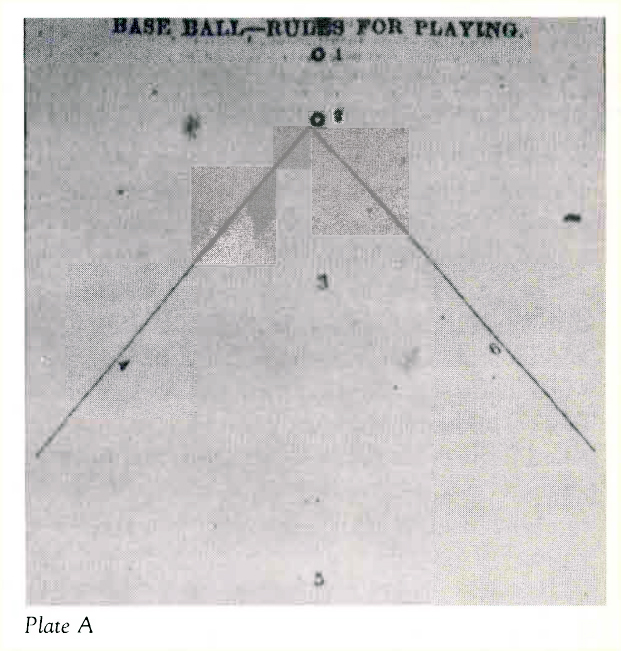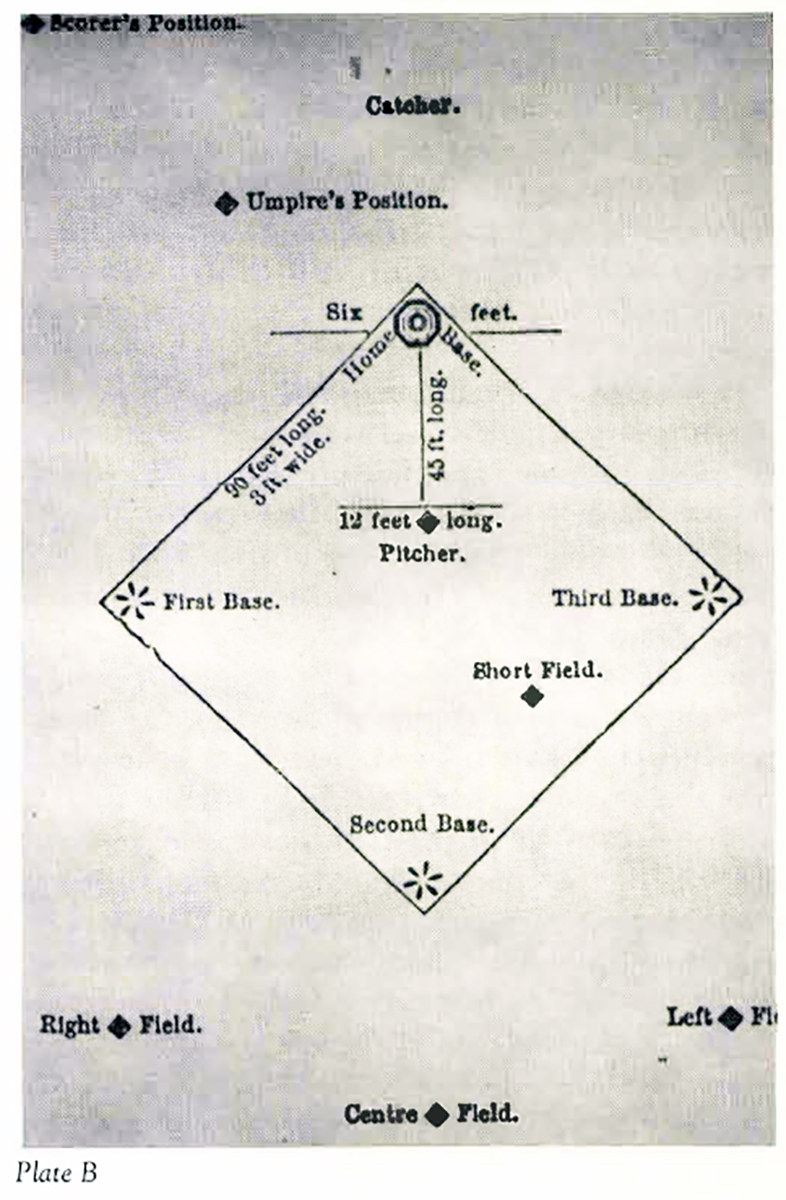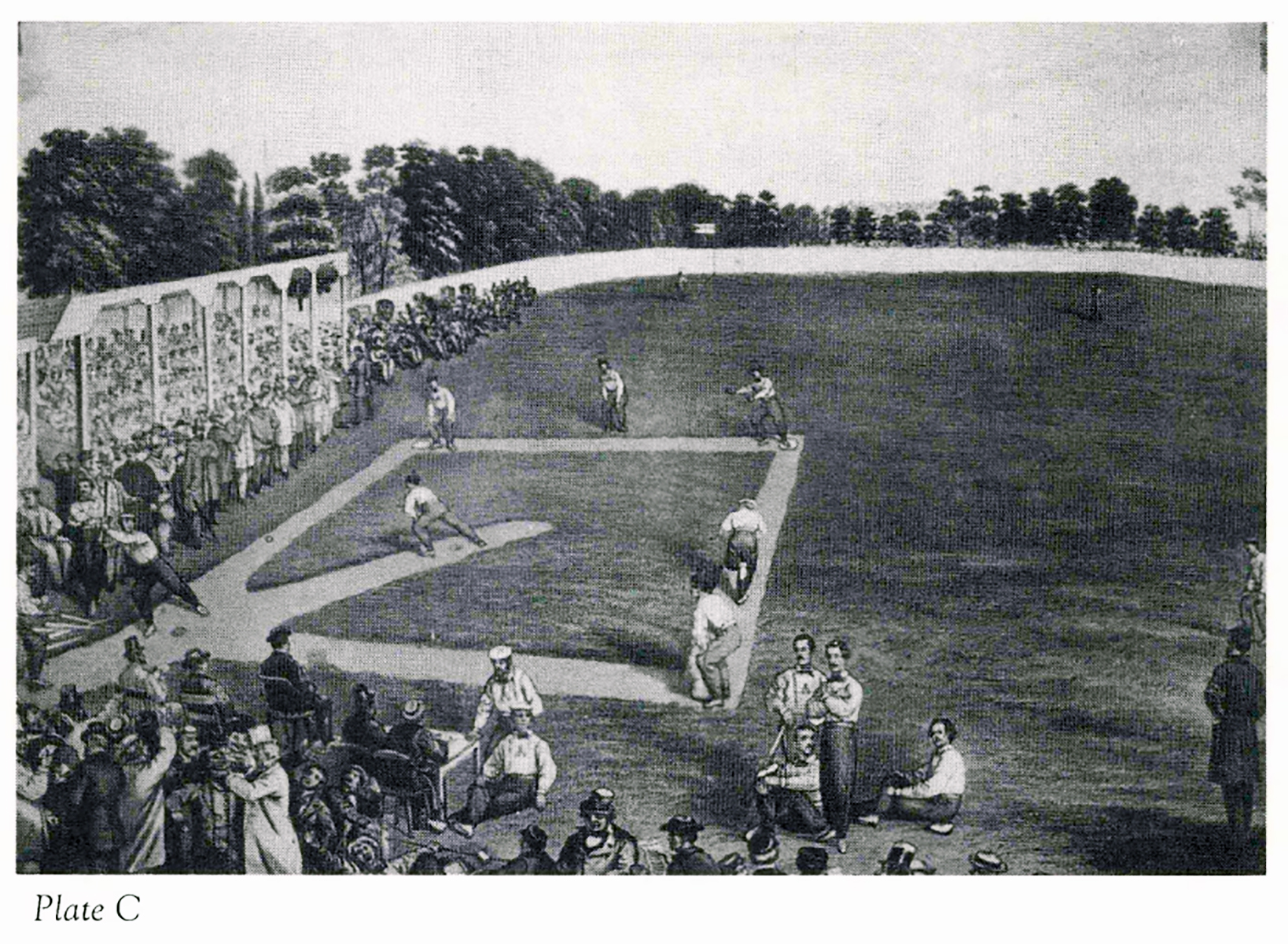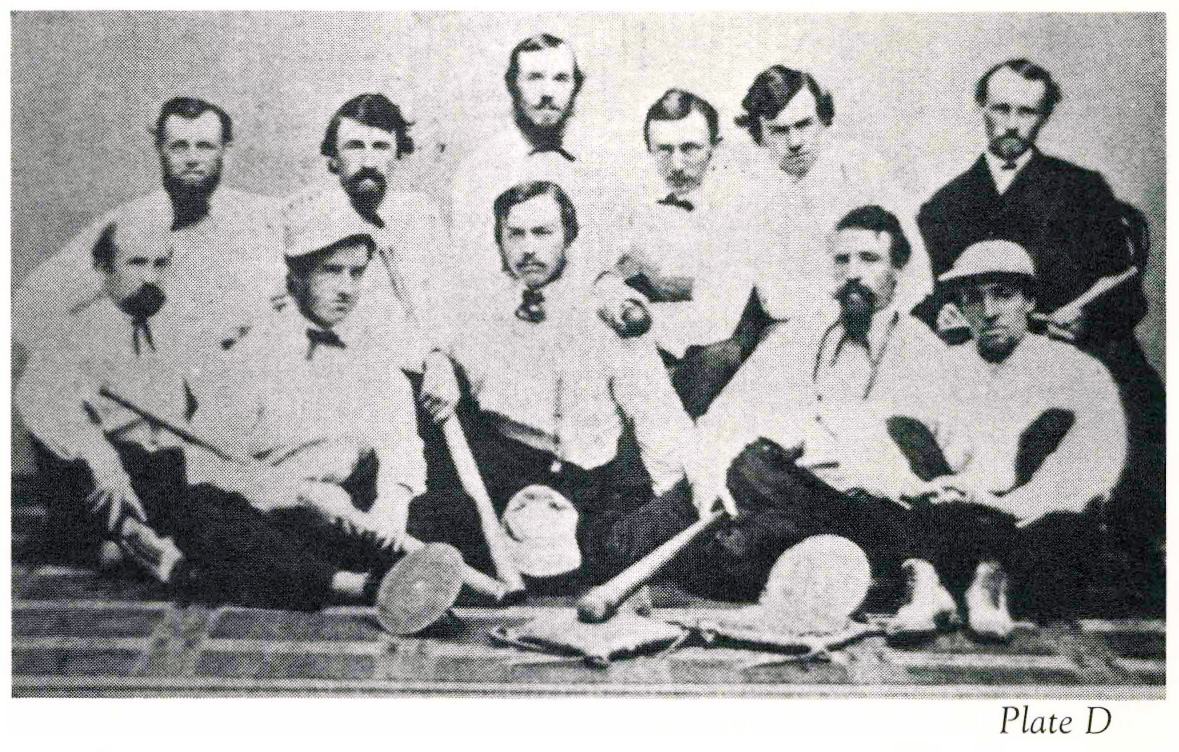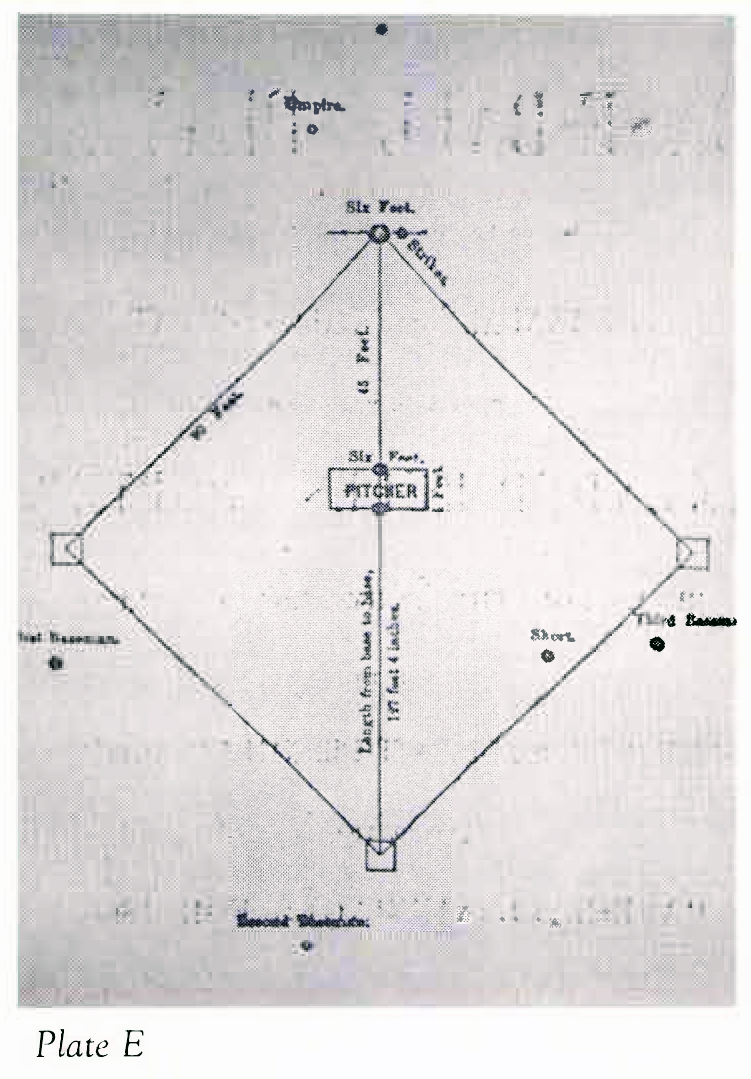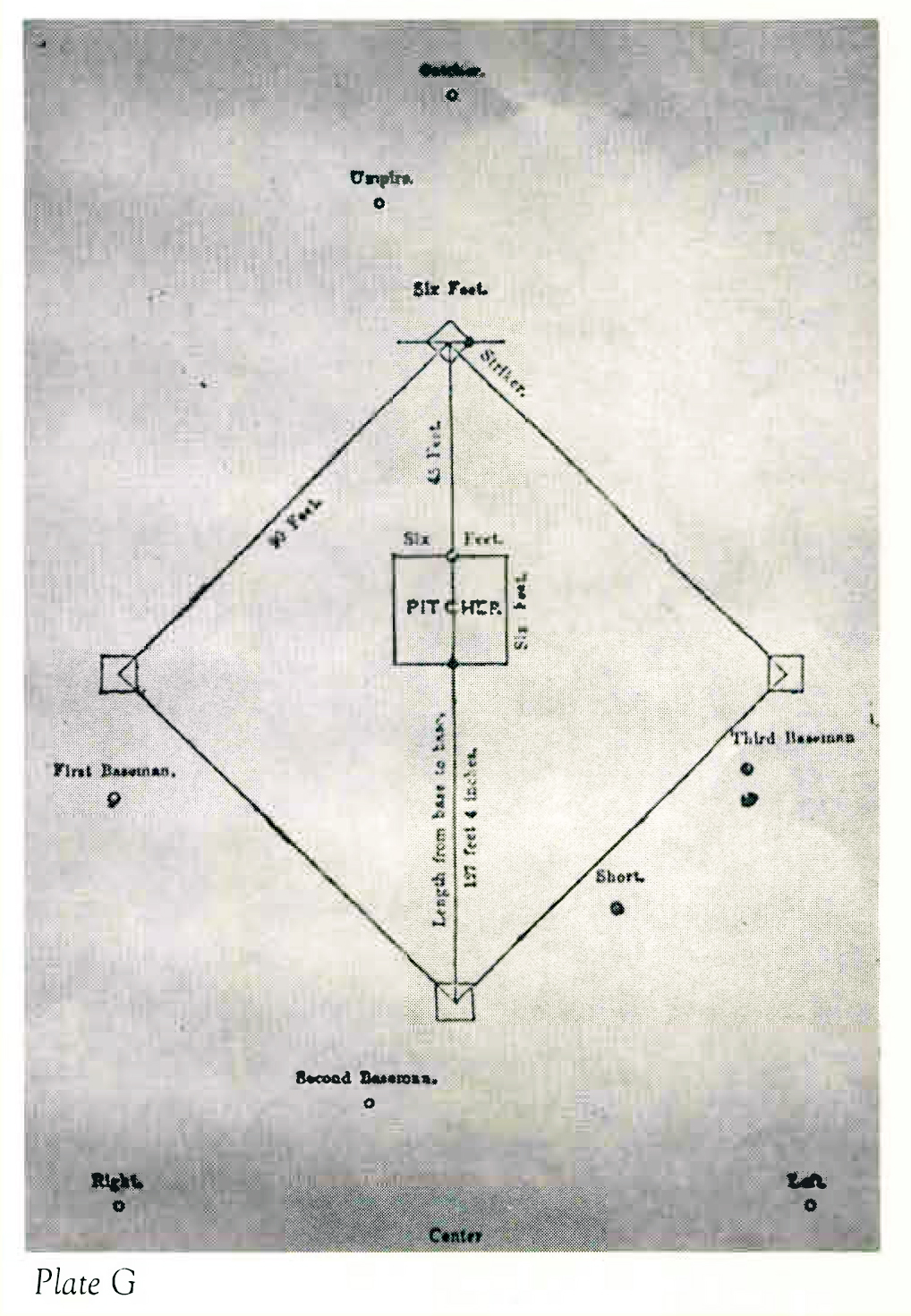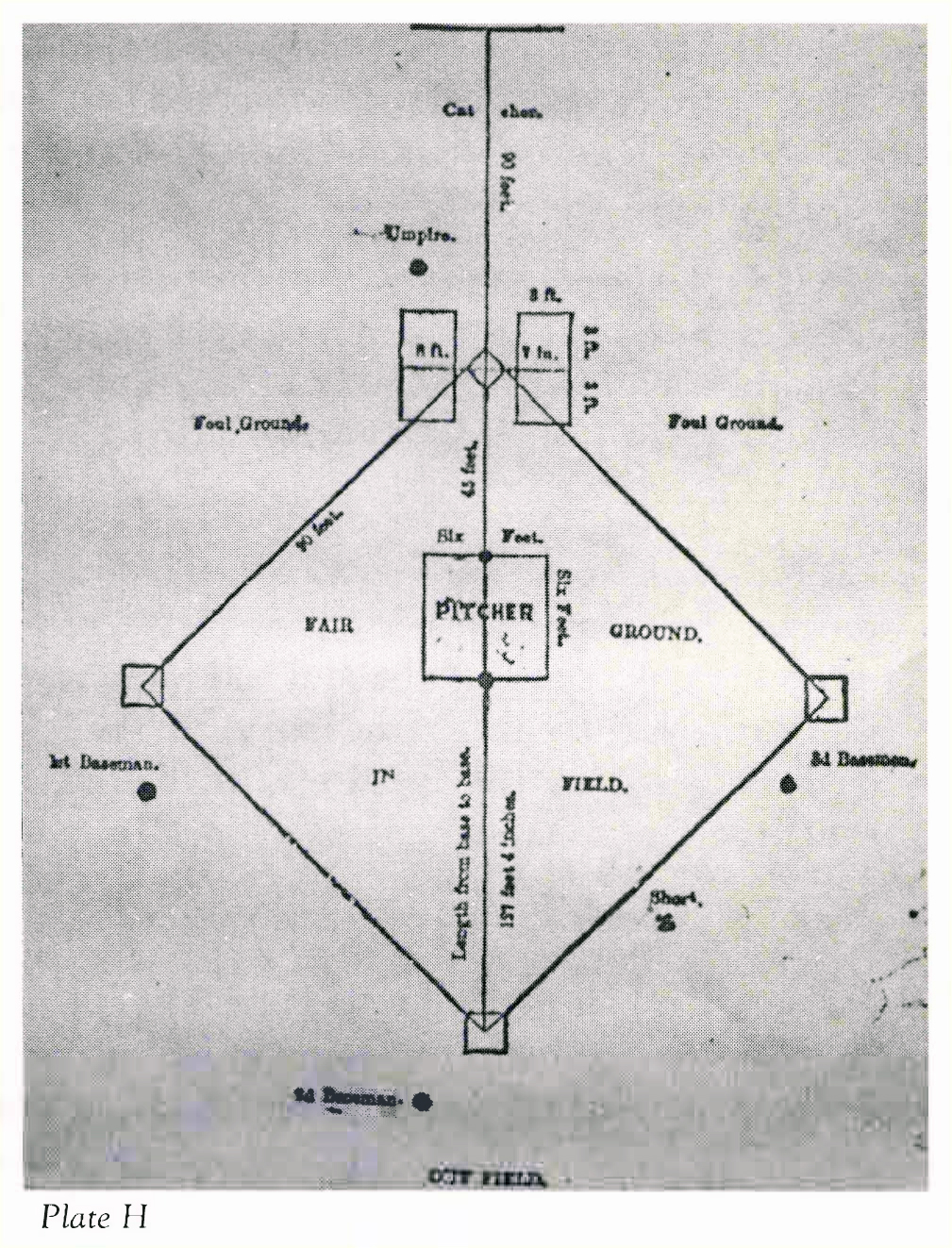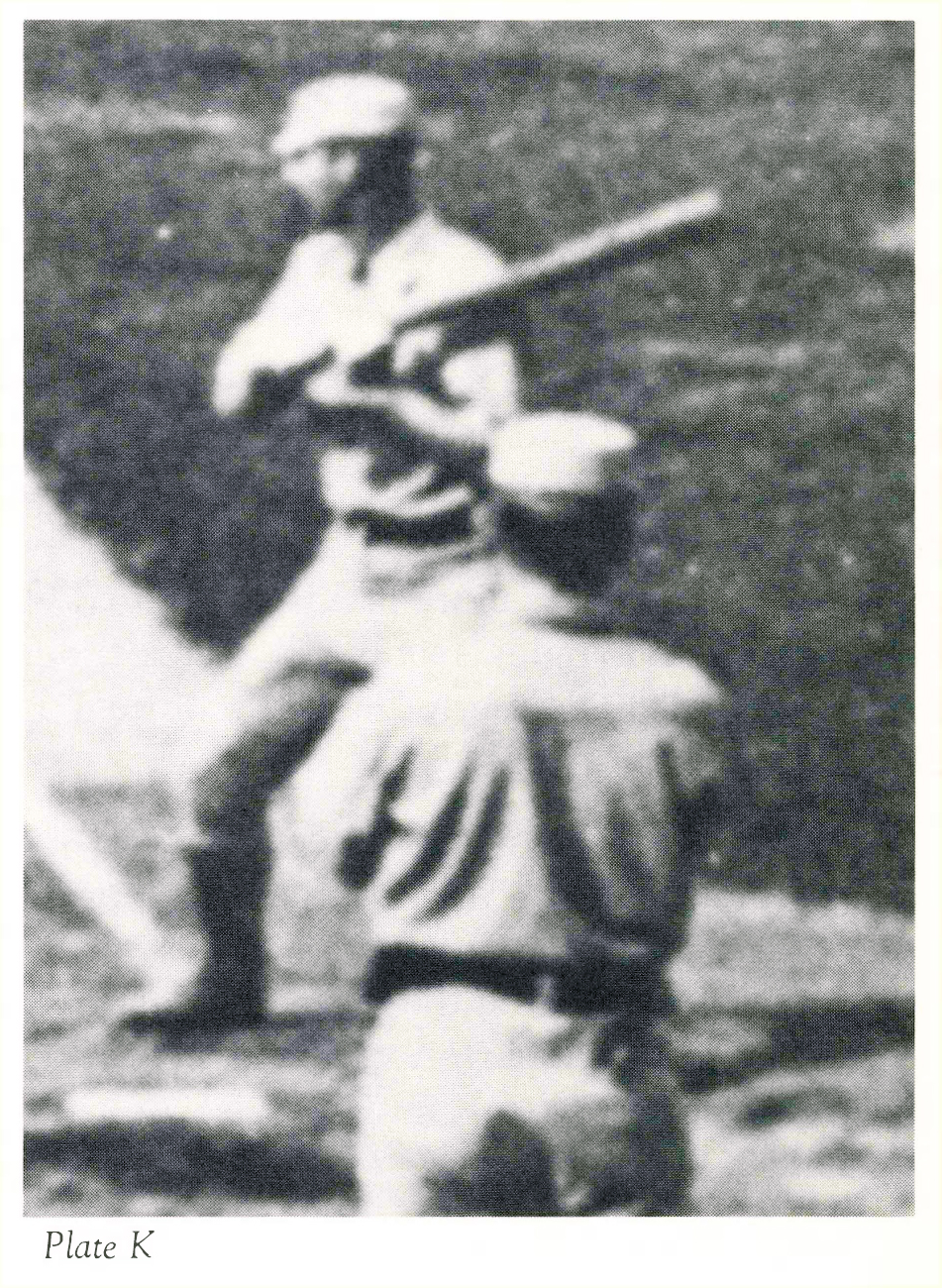The Evolution of the Baseball Diamond: Perfection Came Slowly
This article was written by Tom Shieber
This article was published in SABR 50 at 50
This article was originally published in SABR’s Baseball Research Journal, Vol. 23 (1994).
Red Smith once wrote: “Ninety feet between bases is the nearest to perfection that man has yet achieved.”1 Technically, this statement is incorrect: there has never been 90 feet between bases. In fact, in the nineteenth century, the distance between bases often varied from season to season as changes in the rules altered the placement of the bases on the infield diamond.2 This “perfection” of the baseball diamond did not occur spontaneously, but evolved through more than 50 years of tinkering with the rules of baseball.
The modern baseball diamond is a square with sides 90 feet in length, and is used as an aid in the positioning of the bases and base lines. The term “diamond” was used early in the history of the game to differentiate the infield configuration of the “New York” game of baseball from that used in the “Massachusetts” game. In the New York game the batter, or striker, stood at the bottom corner of the infield, thus viewing a diamond-like positioning of the bases. However, the batter in the Massachusetts game would view the infield as a rectangle.
The positioning, orientation, size and make-up of the bases on the infield diamond were not always explicitly stated in the rules of the game. This lack of definition is not unusual, as much of the game itself was not detailed in the early rules. Rather than defining the game of baseball and how it was to be played, these early rules were used to differentiate the particular version of baseball being played from other similar baseball-like games of the era. Nevertheless, it is possible to trace the basic evolution of the baseball diamond.
The Amateur Era
The New York Knickerbocker Base Ball Club, formally organized in 1845, established the first written rules of baseball.3 Of the original 20 rules, only 14 actually pertained to the game of baseball, and the remaining six concerned club matters. Of the 14 game rules, only the first related to the layout of the playing field: “1. The bases shall be from ‘home’ to second base, 42 paces; from first to third base, 42 paces, equidistant.” Simple application of the Pythagorean theorem shows that a square whose diagonal is 42 paces has sides of slightly less than 30 paces. The Knickerbocker rules made no mention of the exact placement or size of the bases in the infield.
In 1856, an article in the December 13 issue of the New York Clipper listed the rules of baseball. These rules were essentially identical to the original Knickerbocker rules and were published along with a rudimentary diagram of the baseball infield. Unfortunately, the inaccuracies of the diagram render it useless in determining the exact orientation and positions of the bases of the era. In fact, the diagram shows the distance from home to second base to be noticeably longer than the distance from first to third base, though the rules clearly specify equal distances.4 (see plate A.)
Plate A
Early Baseball Diamond Diagram. The New York Clipper, December 13, 1856.
The first convention of baseball players was held in 1857, and a new set of rules, 35 in number, was adopted.5 Sections 3 and 4 of these rules relate to the layout of the baseball diamond:
3. The bases must be four in number, placed at equal distances from each other, and securely fastened upon the four corners of a square, whose sides are respectively thirty yards. They must be so constructed as to be distinctly seen by the umpires and referee, and must cover a space equal to one square foot of surface; the first, second, and third bases shall be canvas bags, painted white, and filled with sand or saw-dust; the home base and pitcher’s point to be each marked by a flat circular iron plate, painted or enameled white.
4. The base from which the ball is struck shall be designated the home base, and must be directly opposite to the second base; the first base must always be that upon the right hand, and the third base that upon the left hand side of the striker, when occupying his position at the home base.6
Rule 3, defining the size of the infield square, was carefully constructed so as to avoid the use of the word “pace.” According to Daniel Adams, Knickerbocker club member and 1857 president of what would later be known as the National Association of Base Ball Players, this rule was rewritten to simply clarify the distances on the ball field, the word “pace” being “rather vague.”7
Adams’s statement implies that the wording of the new rule did not change the size of the infield. Thus, the “pace” was meant to be understood as a measurement approximately equal to three feet. Yet, even today the meaning of the Knickerbocker “pace” is the subject of debate. Some baseball scholars believe the word “pace” should be interpreted as an exact measurement, which, during the 1840s, was defined as 2-1/2 feet.8 Given a pace of 2-1/2 feet and again employing the Pythagorean theorem, each side of the infield diamond would be roughly 74-1/2 feet in length. Other historians take the point of view that a pace, being a unit of measurement defined solely by the individual doing the pacing, allowed for a scalable diamond dependent on the size of the players. Therefore, since a child’s pace is smaller than that of an adult, the diamond as laid out by a child would be proportionally smaller than the adult’s diamond.9
With the question of the true meaning of the pace yet unanswered, the exact size of the Knickerbocker infield square remains uncertain. The first baseball annual, Beadle’s Dime Base-Ball Player, was published in 1860. In this guide, the rules regarding the baseball diamond remained unchanged from those adopted at the 1857 convention, but an accompanying diagram was new. The first, second, and third bases are represented by asterisks (certainly not representative of their actual shape), and home base is represented by the curious figure of an octagon inscribed within a slightly larger octagon (see plate B). Whereas home base was clearly stipulated to be circular, early drawings of baseball games often showed home base as having a smaller circle inscribed upon the plate (see plate C).
Plate B
“Diagram of a Base Ball Field.” Henry Chadwick, ed., Beadle’s Dime Base-Ball Player (New York: Beadle & Co., 1862).
Plate C
Brooklyn Atlantics versus Philadelphia Athletics, October 22, 1866. John Thorn and Mark Rucker, The National Pastime 3, No. 1 (Spring 1984), 24.
Following the official rules section of the 1860 Beadle’s guide is an explanatory section in which editor Henry Chadwick reviewed and elaborated upon some of the rules of the game. With regard to home base, Chadwick stated that it should be “not less than nine inches in diameter.”10 Though there are numerous drawings, there is only one known photograph showing the circular home base (see plate D).
Plate D
Rockingham Nine, Portsmouth, New Hampshire, 1865. John Thorn and Mark Rucker, The National Pastime 3, No. 1 (Spring 1984), 8.
With regard to the first, second, and third bases, Chadwick stated that: “The proper size of a base is about fourteen inches by seventeen; but as long as it covers one square foot of ground … the requirements of the rules will be fulfilled.”11 Note that the official rule required the base to “cover,” not necessarily “be,” one square foot of surface. Thus, by Chadwick’s interpretation of the rule, any base that covers an area greater than or equal to 12 square inches is legal.12
Unfortunately, there are no known photographs or drawings clearly showing the bases of the era to be rectangular. The drawings and photographs that do exist show bases that appear to be square, or quite close to square.13 Nevertheless, the explanatory section in every Beadle’s guide up to and including that of 1871 states that the proper size of a base was 14 by 17 inches.
The rules as published in the 1861 Beadle’s guide contained an addition to section 4:
And in all match games, a line connecting the home and first base and the home and third base, shall be marked by the use of chalk, or other suitable material, so as to be distinctly seen by the umpire.14
The purpose of this rule was to aid the umpire in determining whether a hit ball was fair or foul.15
There were no further rule changes with regard to the layout of the baseball diamond until 1868. However, the 1867 Beadle’s guide featured a departure from the old diagram of the baseball field to a more accurate representation of the infield. The bases are shown with their correct shapes, and, presumably, in their correct positions on the infield square (see plate E).
Plate E
Beadle’s Diagram for 1867. Henry Chadwick, ed., Beadle’s Dime Base-Ball Player (New York: Beadle & Co., 1867).
Though the rules still did not explicitly state how the bases were to be oriented in the infield, the diagram implied that all four bases were to be centered on their respective corners of the infield square and that the first, second, and third bases were to be positioned such that two corners of each base touched the base lines. In other words, the bases were rotated 45 degrees from their more familiar, modem orientation. This strange orientation of the bases is clearly seen in a number of drawings of ball games of the era (see plate F).
Plate F
Brooklyn Atlantics versus Philadelphia Athletics, September 7, 1868. The New York Clipper, September 12, 1868.
A major change in the rules regarding the layout of the baseball diamond occurred for the 1868 season, the first such change since the Knickerbocker rules had been written down more than 20 years before: The words “circular iron” were stricken from section 3 of the official rules. With this change, the rule regarding the size of the other bases was applied to home base as well: home base to “cover a space equal to one square foot of surface.”16 The official rules as published in the 1868 Beadle’s guide noted this change in the shape of home base, but the same guide’s infield diagram and explanatory section failed to reflect this change.17 By the following year these mistakes were rectified. Interestingly, while the official rules still failed to stipulate the exact positioning of the bases on the infield square, the 1869 Beadle’s diagram implied that, unlike the first, second, and third bases, home base was to be oriented with its sides parallel to the base lines (see plate G).
Plate G
Beadle’s Diagram for 1869. Henry Chadwick, ed., Beadle’s Dime Base-Ball Player (New York: Beadle & Co., 1869).
For most of its life, DeWitt’s Base Ball Guide was, like Beadle’s, edited by Henry Chadwick. It, too, contained an explanatory section elaborating upon the rules and play of the game. In the explanatory section of the 1869 DeWitt’s guide, Chadwick stated that all four bases “should be at least eighteen inches square, although the rules prescribe that they shall cover one square foot of surface.”18 Meanwhile, the explanatory section in the 1869 Beadle’s guide still stated that the bases should be “about fourteen inches by seventeen.” Chadwick’s contradictory statements as published in the two guides were repeated for three years. In 1872, the discrepancy was resolved when both guides simply dropped the sections that included the suggested base sizes.
An additional change to the official rules of 1868 occurred with the following amendment to section 4: “The base bag shall be considered the base, and not the post to which it is, or should be, fastened.”19 No doubt, the previous season (or seasons) saw occurrences of bases becoming dislodged from their original position, leaving both runner and fielder dumbfounded as to which one was the true base. The post was a block of wood or stone, sunk into the infield ground and level with the playing surface, to which the bases were attached by stakes (see plate D above).
The Openly Professional Era
With the exception of one minor alteration to the rules, the layout of the infield diamond remained unchanged as the era of openly professional teams dawned. Starting with the season of 1872, home base was no longer to be made of iron, but of “white marble or stone, so fixed in the ground as to be even with the surface.”20
Whereas diagrams of the baseball infield had long since shown first, second, and third bases centered on their respective comers of the diamond, not until 1874 did the rules officially require this placement. The exact positioning of home, first, and third (but technically not second) base was implied in a new foul line rule (rule 5, section 8) stating:
The foul ball lines shall be unlimited in length, and shall run from the center of the home base through the center of the first and the third base to the foul ball posts …21
A change in the exact positioning of home base occurred for the season of 1874. An addition to rule 1, section 6, required home to be “with one corner of it facing the pitcher’s position.”22 This orientation had been implied in diagrams of the baseball infield since 1869. Furthermore, since 1869, Chadwick’s explanatory section of the Beadle’s guide mentioned this orientation of home base.23 The reason behind the clarification of home base’s orientation was simple and well explained by Chadwick in the 1874 DeWitt’s guide:
The [home] base [is] to be fixed in the ground with one corner pointing towards the pitcher’s position, so as to insure the pitcher’s having the full width of the home base to pitch over, instead of the one foot of width he would have were the base to be placed with the square side facing him.24
The rules for the season of 1875 further clarified the position of home base. An addition to rule 1, section 6, required that home base be positioned such that the comer that faces the pitcher “touch the foul ball lines where they meet at the home base comer.”25 This amendment moved home base from a position centered on its comer of the infield diamond to a location completely in foul territory. While the infield diagram found in the 1875 Beadle’s guide failed to reflect this move of home base, the diagram in the De Witt’s guide of that year did show the change.
To understand the reason behind this rule change, it is necessary to review what was known as the “fair-foul” hit. The fair-foul hit was a particular technique of hitting that took advantage of the fair and foul ball rules of the day. These rules, from “Rule V – The Batting Department,” were as follows:
11) If the ball from a fair stroke of the bat first touches the ground, the person of a player, or any other object, either in front of, or on, the foul ball lines, it shall be considered fair.
12) If the ball from a fair stroke of the bat first touches the ground, the person of a player, or any other object behind the foul ball lines, it shall be declared foul; and the ball so hit shall be called foul by the umpire even before touching the ground, if it be seen falling foul.26
In summary, a ball that initially landed in fair territory, regardless of whether it stayed in fair territory or whether it passed first or third base in fair territory, was a fair ball. A fair-foul hit was one in which the batter deftly hit the ball such that it first touched the ground in fair territory and then bounded into foul territory. Often the fielders would have to run a great distance into foul territory to retrieve such a hit ball. To shorten this distance, the first and third basemen would play quite close to the foul lines, which subsequently opened up large gaps in the infield and allowed what would otherwise be easy ground ball outs to safely make it to the outfield as hits.
Henry Chadwick, among others, was eager to lessen the impact of the fair-foul hit. To meet this end, he proposed adding a tenth man (or “right shortstop”) to each team so that the large gaps in the infield would be narrowed.27 Chadwick popularized this idea by writing special sections in both the Beadle’s and DeWitt’s guides of 1874 suggesting the use of the 10-man rule. However, though the Beadle’s guide of 1875 as well as the DeWitt’s guides from 1875 to 1882 continued to have sections clearly implying that the 10-man rule was the norm for organized baseball, the 10-man game was never adopted into the official rules of the game.28
The rule change for 1875 called for home base to move from its former position, centered on its comer of the diamond, back approximately 8-1/2 inches, such that it was located completely in foul territory. This change also moved the batter back a distance into foul territory and thus made it more difficult for him to successfully make a fair-foul hit.29 This change in the batter’s position did not solve the “problem” of fair-foul hitting; in 1877, the fair-foul hit was eliminated from the game altogether by changing the definition of a fair ball essentially to the modern rule.
The Emergence of the National League
For 1876, the inaugural season of the National League, the rules of the game called for an infield diamond that had the following characteristics: The four bases each covered 12 inches square; home base was located in foul territory, its front corner touching the junction of the first- and third-base lines; the first, second, and third bases were centered on their respective corners of the infield square, and oriented such that two corners of each base touched the base lines. The orientation of the first, second, and third bases, as well as the exact position of the second base, were still only implied by the diagrams that supplemented the published rules. Furthermore, while the diagram printed in the new 1876 Spalding’s Official Base Ball Guide correctly showed this layout of the infield, the diagram in the 1876 Beadle’s guide still failed to show home base in foul territory.
For the year of 1876 alone, the rules in both Beadle’s and DeWitt’s guides, but not those in the Spalding guide, allowed home base to be composed of wood. By the following year, however, none of the guides mentioned a wooden home base.
Two major changes in the infield diamond rules were introduced for the season of 1877. The first change moved home base for the second time in three years. This time home base was to be positioned “wholly within the diamond. One corner of said base shall face the pitcher’s position, and two sides shall form part of the foul lines.”30 With this change, and after two years of printing erroneous diagrams, the 1877 guide finally contained a diagram that correctly reflected the state of the infield diamond, home base being shown completely in fair territory.
The second infield change for 1877 concerned the size of the bases. “The first, second and third bases must cover a space equal to fifteen inches square …”31 Home base remained a square foot in size.
Whereas the infield diagram in the 1877 Beadle’s guide still showed the first, second, and third bases rotated 45 degrees from their current orientation (see plate H), the diagrams in the 1877 DeWitt’s and Spalding guides no longer showed the bases in this skewed orientation. Instead, they showed the base sides parallel to the base paths, as they are today (see plate J). Nevertheless, the orientation of these bases was not explicitly stated in the official rules at the time.32
Plate H
“Diagram of the Diamond Field.” Henry Chadwick, ed., Beadle’s Dime Base-Ball Player (New York: Beadle & Adams, 1877).
Plate J
“Diagram of a Ball Ground.” A.G. Spalding and Lewis Meacham, eds., Spalding’s Official Base Ball Guide for 1878 (Chicago: A.G. Spalding & Bro., 1878), 3.
The 1880s
Prior to the 1880 season, the official rules of the game were completely rewritten, rearranged, and, in general, improved. Though much of the wording regarding the layout of the infield diamond was altered, the state of the infield itself remained unchanged. However, the positioning of the first, second, and third bases was made explicit by new wording of the rules: “… the center of each [base] shall be upon a separate corner of the infield …”33
No further changes were made to the rules regarding the baseball diamond until 1885. For that season, it was no longer acceptable to have home base made of marble. Home could now be composed only of “white rubber or white stone.”34 The change was made to help prevent players from slipping on the slick marble plate. The rules of the three-year-old American Association departed from those of the National League and called for white rubber home bases only.
The only major differences between the infield diamond of 1885 and that of over a century later are the positions of the first and third bases, and the shape of the square home base of the era are numerous, clear pictures of the first and third base bags centered on the base paths are quite difficult to locate. This positioning of the bases is best seen in a photograph that was taken prior to the April 29, 1886, opening day game at the Polo Grounds in New York City (see plate K).
Plate K
Boston Beaneaters versus New York Giants, April 29, 1886. John Thorn and Mark Rucker, The National Pastime 3, No. 1 (Spring 1984), 50.
The year 1887 brought about a single set of rules embraced by both the National League and the American Association. The two leagues compromised with regard to the layout of the infield diamond: the National League adopted the American Association rule requiring home base to be made only of white rubber. Furthermore, the rules for this season altered the positions of the bases:
The first, second and third bases must be…so placed that the center of the second base shall be upon its corner of the infield, and the center of the first and third bases shall be on the lines running to and from second base and seven and one-half inches from the foul lines, providing that each base be entirely within the foul lines.35
Why change the positions of first and third base? Prior to 1887, if a batted ball hit first or third base, the umpire was faced with a most difficult decision as to whether the ball was fair or foul. A ball hitting the half of the base that was in fair territory was a fair ball, while a ball hitting the other half of the base was a foul ball. At times, deciding which half of the base had been hit was practically impossible. Moving first and third base completely into fair territory made the decision academic: if the ball hit the base, it had to be a fair ball.
Note that according to the wording of the rule, the first and third bases were to be positioned such that they straddle the base lines to and from second base. However, the diagram that accompanied the rules in the 1887 Spalding guide shows the bases positioned as they are today, neatly nestled in their respective corners of the 90-foot infield square (see Plate L).36
Plate L
“Correct Diagram of a Ball Ground.” Spalding’s Base Ball Guide for 1887 (Chicago: A.G. Spalding & Bros., 1887), 4.
Interestingly, it was the diagram, not the wording of the rule, that prevailed. To this day, second base remains “upon its corner of the infield,” while the first and third bases lie wholly within the diamond. This rather strange positioning of second base is often overlooked in modern-day representations of the baseball diamond. Even the cover of The Macmillan Baseball Encyclopedia shows an infield diamond with second base erroneously placed wholly within the 90-foot infield square. Modern day rules avoid any possible conflict between the written rule and the diagram by essentially stating that the diamond should be laid out so that it looks like the diagram supplied.
The Modern Baseball Diamond
In 1894, a new, more mathematical and geometrical diagram of the baseball diamond accompanied the Spalding guide rules.37 While the actual layout of the diamond did not change, it was now more precisely defined with labeled points and angles. Henry Chadwick thought the new, complicated description of the infield a bit ridiculous:
The diagram of the diamond needs a surveyor to lay it out so that it might be made comprehensible to amateurs and novices in the game. What with its “arcs” and its “radiuses” and its algebraic style of description, it is likely to be a greek puzzle to foreign votaries of the game.38
As the turn of the century approached, the infield diamond was basically identical to that of today with but one notable exception: the shape of home base. This final significant change to the diamond rules was implemented for the 1900 season. Two triangular areas were added to the front of the square home base such that the front was no longer a point, but a 17-inch wide, flat side of the now familiar five-sided shape. The Spalding guide of 1900 explained the reason for the change:
With the plate placed in accordance with the form of the diamond field, that is, with its corner facing the pitcher instead of one of its sides, a width of 17 inches was presented for the pitcher to throw the ball over instead of 12 inches, the width of each side of the base. But this left the pitcher handicapped by having to “cut the comers” as it is called, besides which the umpire, in judging called balls and strikes, found it difficult to judge the “cut the corner” balls. To obviate this difficulty, the Committee [of Rules], while keeping the square plate in its old place—touching the lines of the diamond on two of its sides—gave it a new form in its fronting the pitcher, by making the front square with its width of 17 inches, the same as from corner to corner, from foul line to foul line. The change made is undoubtedly an advantage alike to the pitcher and umpire, as it enables the pitcher to see the width of base he has to throw the ball over better than before, and the umpire can judge called balls and strikes with less difficulty.39
The invention of the five-sided home base was claimed by National League pitcher Crazy Schmit. In a letter he sent to The Sporting News, Schmit states that he suggested the five-sided home base to James Hart (chairman of the Baseball Rules Committee) two years earlier. After briefly mentioning his invention, Schmit goes on at length to detail his career in a style uncannily reminiscent of Jack Keefe, the “busher” pitcher made famous in Ring Lardner’s story You Know Me, Al. Recounting the previous season, Schmit writes:
I pitched some 14 exceptional good games for Cleveland last summer [2-17, 5.86 in 1899]. I am like a gnarled oak and am getting better every year. l may pitch in some smaller league this year. [Charlie] Comiskey says he will give me a chance when things are settled. I had everything arranged to play for [John] McGraw, but if he goes to St. Louis it is all off.40
The majority of Schmit’s letter is spent listing excuses for many of his 17 losses with the dismal 1899 Spiders. Unfortunately for Schmit, McGraw did go to St. Louis, and Crazy pitched in only four more major-league games, winning none and losing two. Schmit (apparently sensitive of his “Crazy” moniker) ended his letter as follows: “I hope you will not add any nicknames to my name. I remain your humble reader. Frederick Schmit.” Whether or not the idea for the five-sided home plate really came from Schmit remains unclear. The fact that he has one of the worst winning percentages (7-36, .163) in baseball history does not.41
Former baseball commissioner Ford Frick wrote:
…The establishment of the 90-foot distance between bases must be recognized as the greatest contribution to perfect competition any game has ever known. It is that specification on which our hitting and fielding records are based; that unchanging measurement of success or failure that has set the guidelines for heroes; the great reason why baseball, through the years, has qualified as the most mathematically perfect game ever devised by humankind.42
Like Red Smith, Frick describes the baseball diamond as being “perfect.” It is the awkward-looking home plate, the strange positioning of the second base, and the first and third bases nestled snugly in their corners of this 90-foot square that we embrace as perfection.
TOM SHIEBER operates a solar telescope at Mount Wilson Observatory in Southern California. He currently chairs the SABR Pictorial History Committee.
Acknowledgements
Thanks go to Tom Heitz, Liane Hirabayashi, Fred Ivor-Campbell, Larry Webster, and the library staffs of both the National Baseball Library in Cooperstown, New York, and the Paul Ziffren Sports Resource Center at the Amateur Athletic Foundation of Los Angeles.
CHRONOLOGY OF BASEBALL DIAMOND RULE CHANGES
- 1845: First written rules of baseball set down by the Knickerbocker Base Ball Club of New York City.
Distance across infield diamond (home to second and first to third) is set at 42 paces. - 1857: New set of rules adopted at first convention of baseball players.
The sides of the infield square are 30 yards.
First, second, and third bases must each cover a square foot in area and are canvas bags filled with sawdust or sand.
Home base is circular and made of iron. - 1860: In Beadle’s guide explanatory section, Henry Chadwick suggests that first, second, and third bases be 14 by 17 inches and that home base be at least nine inches in diameter.
- 1861: Rule requires that chalk lines be drawn between home and first and home and third.
- 1867: Beadle’s guide publishes first truly representational diagram of baseball diamond.
- 1868: Home base changed from a circle to a square.
Size of home base same as that of first, second, and third bases.
Clarification in the rules states that the base bag, not the pose to which the bag should be attached, is to be considered the base. This rule dropped in 1876 according to the Spalding guide; 1877 according to Beadle’s and DeWitt’s guides. - 1869: In DeWitt’s guide explanatory section, Henry Chadwick suggests first, second, and third bases be eighteen inches square.
- 1872: Beadle’s and DeWitt’s guides no longer contain explanatory sections. Discrepancy between suggested sizes of first, second, and third bases (14 by 17 inches versus 18 inches square) is thus removed.
Home base required to be made of white marble or stone. - 1874: Foul line rule implies home, first, and third bases are centered on foul lines.
- 1875: Home base required to have one point facing pitcher and is positioned wholly in foul territory.
- 1876: Beadle’s and DeWitt’s guides allow wooden home base; the Spalding guide docs not.
- 1877: Home base moved wholly into fair territory.
First, second, and third bases are to cover 15 inches square. Home base still to cover 12 inches square.
Fair-foul hit removed from the game, as definition of fair and foul balls are changed.
Spalding and DeWitt’s guide diagrams show bases with sides parallel to base paths. Beadle’s guide will continue to show first, second, and third bases rotated 45 degrees from their modern orientation through 1881, the final year of its publication.
Beadle’s and DeWitt’s guides no longer allow wooden home base. - 1885: National League home base made of white rubber or stone. American Association home base made only of white rubber.
- 1887: National League and American Association adopt same set of rules.
Home base made only of white rubber.
First and third bases moved into fair territory. - 1894: New geometric diagram of baseball diamond adopted.
- 1900: Home base changed to five-sided shape.
Notes
1 Kevin Nelson, Baseball’s Greatest Quotes (New York: Simon and Schuster, 1982), 183.
2 For example, the distance between first and second base on the modern infield diamond is, at its shortest, 88 feet 1.5 inches.
3 Harold Seymour, Baseball: The Early Years, Vol. I (New York: Oxford University Press, 1960-1990), 15-18.
4 John Thorn, “The True Father of Baseball,” chap. 1 in Total Baseball (New York: HarperCollins Publishers, HarperPerennial, 1991), 6.
5 Frederick Ivor-Camphell argued in favor of this scalable pace in his research presentation “Why Forty-Two Paces’” at the 23rd SABR National Convention, June 26, 1993. Ivor-Campbell also noted that deliberate pacing for an adult male can reasonably yield a three-foot pace and, thus, an infield square with sides 90 feet in length.
6 A similar diagram and set of rules were published in The Spirit of the Times, May 12, 1855.
7 The initial convention was held January 22, 1857, but the rules were officially accepted at a later meeting, held on February 25, 1857. Not until the convention of the following year, held March 10, 1858, did the organization name itself the “National Association of Base Ball Players.”
8 Ibid., 6.
9 Ivor-Campbell, op. cit.
10 Henry Chadwick, ed., Beadle’s Dime Base-Ball Player (New York: Irwin P. Beadle & Co., 1860), 18.
11 Ibid.
12 According to an article in the New York Clipper, May 20, 1865, bases a cubic foot in size were used in Philadelphia in 1860. However, it is unclear that the game in which these bases were used was what one would refer to as baseball. Certainly the use of such bases was not the norm for the era.
13 “One of the earliest patents of a baseball base is U.S. Patent No. 75,076. The device is a base that is attached to a stake by means of a swiveling cap. The diagram accompanying the description of the patent shows the canvas base to be circular, though it is clearly not intended for use as a home base. It is unknown whether the device was ever manufactured.
14 Henry Chadwick, Beadle’s Dime Base-Ball Player (New York: Beadle & Co., 1861), 12.
15 According to the 1861 Beadle’s guide, some clubs had adopted this rule during the season of 1860.
16 Henry Chadwick, ed., Beadle’s Dime Base-Ball Player (New York: Beadle & Co., 1868), 17.
17 Curiously, the New York Clipper, December 21, 1867 and December 28, 1867, failed to make note of the change of home from a circle to a square in articles detailing the rule changes for the upcoming 1868 season.
18 Henry Chadwick, ed., The Base-Ball Guide for 1869 (New York: Robert M. DeWitt, 1869), 30.
19 Henry Chadwick, ed., Beadle’s Dime Base-Ball Player (New York: Beadle & Co., 1868), 17. In Appendix 4, “Rules and Scoring of Baseball,” (New York: HarperCollins Publishers, HarperPerennial, 1993), Dennis Bingham and Tom Heitz state that this rule was dropped in 1876. While the 1876 Spalding guide no longer includes this rule, both the Beadle’s and DeWitt’s guides of that year do. All three guides omit the rule for 1877.
20 Henry Chadwick, The Base-Ball Guide for 1872 (New York: Robert M. DeWitt, 1872), 111.
21 Henry Chadwick, ed., Beadle’s Dime Base-Ball Player (New York: Beadle & Adams, 1874), 76.
22 Henry Chadwick, DeWitt’s Base-Ball Guide for 1874 (New York: Robert M. DeWitt, 1874), 76.
23 Henry Chadwick, ed., Beadle’s Dime Base-Ball Player (New York: Beadle & Co., 1869), 14.
24 Ibid.
25 Henry Chadwick, DeWitt’s Base-Ball Guide for 1875 (New York: Robert M. DeWitt, 1875), 74.
26 Ibid., 83.
27 John Thorn, telephone conversation with author, June 11, 1993.
28 The idea of a 10-man game was not new. Not uncommonly, box scores of baseball games from the 1860s showed 10 men per team, the extra man noted as playing “RS” or right shortstop.
29 While the batter’s box moved back 8-1/2 inches with the move of home base, the same season of 1875 called for a change in the lines of the batter’s box that resulted in the batter being moved an extra foot away from their territory.
30 The Sporting Life, November 26, 1884: 3.
31 Henry Chadwick, DeWitt’s Base-Ball Guide for 1877 (New York: Robert M. DeWitt, 1877), 64.
32 From 1867 to 1881, the final year of its publication, the Beadle’s guide diagram of the baseball infield showed the first, second, and third bases to be rotated 45 degrees from their modern orientation.
33 Spalding’s Base Ball Guide for 1880 (Chicago: A.G. Spalding & Bros., 1880), 59.
34 Spalding’s Base Ball Guide for 1885 (Chicago: A.G. Spalding & Bros., 1885), 108.
35 Spalding’s Base Ball Guide for 1887 (Chicago: A.G. Spalding & Bros., 1887), 107.
36 Ibid.
37 Henry Chadwick, ed., Spalding’s Base Ball Guide for 1894 (New York: American Sports Publishing Company, 1894), 152.
38 By this time both the Beadle’s and DeWitt’s guides were no longer published. Beadle’s last year of publication was 1881, while DeWitt’s was 1885.
39 Henry Chadwick, ed., Spalding’s Official Base Ball Guide (New York: American Sports Publishing Company, 1900), 201.
40 “The New Home Plate,” The Sporting News, March 24, 1900.
41 Jack Wadsworth has the worst won-loss percentage for a pitcher with at least five victories: 6-38, .136. However, as of the end of the 1993 season, Anthony Young’s record stood at 5-35, .143.
42 Ford Frick, Games, Asterisks, and People: Memoirs of a Lucky Fan (New York: Crown Publishers, Inc., 1973), 9. Note that, like Red Smith, Frick erroneously states the distance between bases to be 90 feet.



